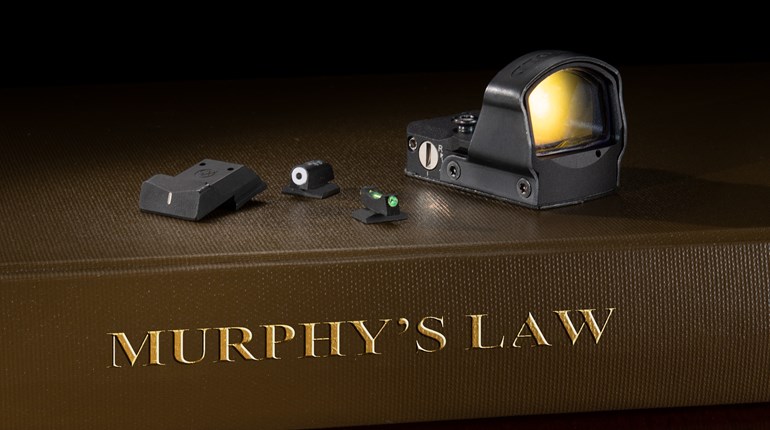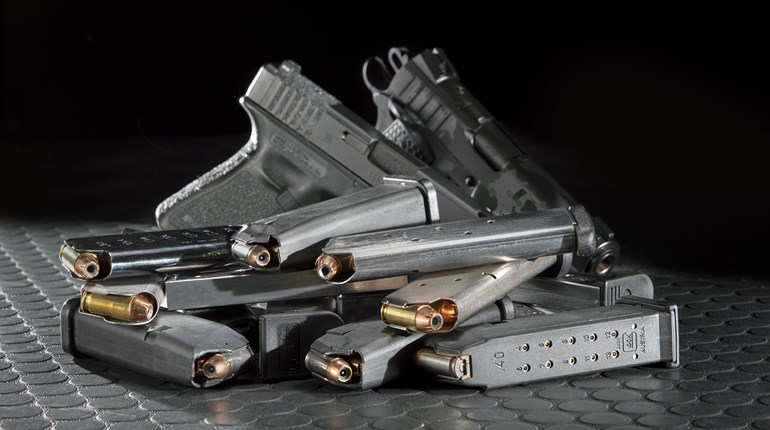
Not all of today’s polymer-frame pistols contain striker-fired ignition systems. Hammers can be impactful to both primers and sales.
One of the problems inherent in both being involved with the world of firearms for a long enough time and/or reaching a certain age is you realize you remember a “Before Times” that not everyone around you is able to recall.
For instance, over the last several years I’ve seen numerous internet gun personalities use the term “striker-fired pistol” as a rough synonym for “modern handgun.”
In a way this is understandable. The vast majority of major duty-type sidearm launches from large manufacturers during the last two decades have involved polymer-frame, striker-fired handguns that were more than a little similar to the Austrian “Drastic Plastic.” Even former hammer-fired holdouts, titans of the metal-frame traditional DA/SA world like SIG Sauer, CZ and Beretta had bowed to the seemingly inevitable with pistols like the P320, P10 and APX.
The thing is, there’s nothing inherently more modern about striker-fired lockwork. Indeed, John Browning’s first commercially successful semi-automatic pistol design, the FN Model 1899, was striker-fired. There’s nothing new except what’s been forgotten.
Here’s a thing that you had to be around in the 1980s and ’90s to really appreciate: Back when it was new, Glock received nearly as much pushback from traditionalists for the striker-fired action as it did for the polymer frame, and the reason for that is the same reason Glock used a striker in the first place. They’re cheap to make.
I was thumbing through a 1992 firearm-buyer’s guide annual from some magazine or another the other day, and it was notable just how few pistols used strikers back then. Other than the Glock and H&K’s weird platypus P7 series, striker-fired operation was pretty much the sole province of inexpensive zinc-alloy blowback guns from the sort of manufacturers at which brand-conscious buyers would turn up their noses. Because striker-fired pistols are cheap to make.
Glock was just the first manufacturer to crack the code on manufacturing a pistol as inexpensively as possible while still making it rugged and reliable, and they ate everyone else’s lunch in the duty-pistol market because of it. The Austrian guns could be sold cheaper than Smith & Wesson or SIG could ever slash their metal, hammer-fired duty pistols and still turn a greater profit, and that’s how we ended up where we are now.
Hammer-fired ignition systems still had a couple of advantages, though. The smaller advantage was that they could more reliably ignite harder primers. This isn’t much of a factor for the domestic shooter who can choose their ammunition, or even load their own. Anyone who’s spent enough time mixing striker-fired pistols and oddball foreign military ball ammo, though, has probably noticed a slightly greater rate of reluctant primers. This is because the striker only has its own momentum, propelled by a little bitty spring in the striker channel of the slide, with which to bust the cap. A hammer-fired ignition system, on the other hand, can stuff a whopping-big spring down in the frame, which then propels a heavy hammer to whack the firing pin.
There’s another, bigger advantage to the hammer-operated ignition system, and it’s come to completely dominate a certain segment of the handgun market because of it. The reason for this is almost entirely because of George Kellgren.
Pocket pistols tended to fall into two categories: Inexpensive blowback-operated ones using striker-fired actions, and expensive blowback-operated ones using hammer-fired actions.
The inexpensive striker-fired ones were bigger and heavier because, in a striker-fired blowback gun, there’s nothing resisting the rearward motion of the slide other than the recoil spring and the mass of the slide itself. This put an effective upper-caliber limit on pocket pistols, otherwise the slide would be too bulky to pocket, or the recoil spring would be too heavy for most people to hand-cycle the slide.
For manufacturers willing to add the expense of a hammer-fired action, though, a third braking force was added to slow the slide’s rearward travel. Remember how a hammer gun could have a big ol’ spring down in the frame, rather than a dinky one in the striker channel? Well, when moving rearward, the slide had to force the hammer back against the tension of this spring. This is why slides of the Seecamp LWS 32 and Beretta Jetfire were so much less bulky than the ones on, say, a Raven .25 or Davis .32 ACP. (Pistolsmiths who work on 1911s use this fact to tune pistols by tinkering with the bevel on the bottom of the firing pin stop, which affects its leverage against the hammer.)
Kellgren, who’d already exploited the braking forces of a hammer to make very compact .380 ACP and 9 mm pistols, realized he could change the whole paradigm of the pocket semi-auto this way, using nothing but existing technology. Released in 1999, the KelTec P-32 combined an injection-molded polymer frame, like a Glock, with a hammer-fired action and Browning-type short-recoil, tilting-barrel, locked-breech operation to make a very inexpensive, very small pistol chambered in .32 ACP.
Because it was locked breech and hammer fired, it was a fraction of the size of the zinc-alloy, striker-fired blowback pistols from Davis or Lorcin. Because it was polymer framed, it was a fraction of the weight and cost of a Seecamp LWS 32 or Beretta 3032 Tomcat. They sold like hotcakes, even more so after they got bumped up to .380 ACP, and now bunches of manufacturers have hopped on that still-rolling bandwagon.
That slide-velocity-absorbing property of a hammer-fired action gets used in a lot of pistols now. For instance, the 5.7x28 mm pistols from FN and Ruger use an internal hammer as part of the mechanism to retard the slide against the rearward velocities imparted by that hot, bottlenecked round. Additionally, if the internal hammer is cocked, its braking force is not applied to the slide when hand-cycled. Nowadays, that cocked hammer gets hidden inside the slide and the label “EZ” or similar gets engraved on the outside.
It seems it’s hammer time, again.





































